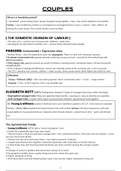Study guide
AQA Sociology A level Paper 2: Families & Households (Topics 1 - 7)
- Institution
- AQA
A* student for Sociology! Topics include: 1. Couples 2. Childhood 3. Theories of Family 4. Demography 5. Changing Family Patterns 6. Family Diversity 7. Social Policy I hope my notes will help you gain an A* too!
[Show more]




